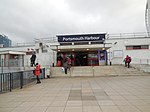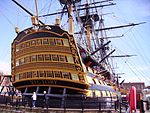HMS Warrior (1860)

HMS Warrior is a 40-gun steam-powered armoured frigate built for the Royal Navy in 1859–1861. She was the name ship of the Warrior-class ironclads. Warrior and her sister ship HMS Black Prince were the first armour-plated, iron-hulled warships, and were built in response to France's launching in 1859 of the first ocean-going ironclad warship, the wooden-hulled Gloire. Warrior conducted a publicity tour of Great Britain in 1863 and spent her active career with the Channel Squadron. Obsolescent following the 1873 commissioning of the mastless and more capable HMS Devastation, she was placed in reserve in 1875, and was "paid off" – decommissioned – in 1883. She subsequently served as a storeship and depot ship, and in 1904 was assigned to the Royal Navy's torpedo training school. The ship was converted into an oil jetty in 1927 and remained in that role until 1979, at which point she was donated by the Navy to The Maritime Trust for restoration. The restoration process took eight years, during which many of her features and fittings were either restored or recreated. When this was finished she returned to Portsmouth as a museum ship. Listed as part of the National Historic Fleet, Warrior has been based in Portsmouth since 1987.
Excerpt from the Wikipedia article HMS Warrior (1860) (License: CC BY-SA 3.0, Authors, Images).HMS Warrior (1860)
Gosport Ferry Piazza, Portsmouth Portsea
Geographical coordinates (GPS) Address External links Nearby Places Show on map
Geographical coordinates (GPS)
| Latitude | Longitude |
|---|---|
| N 50.798333333333 ° | E -1.1088888888889 ° |
Address
HMS Warrior
Gosport Ferry Piazza
PO1 3PA Portsmouth, Portsea
England, United Kingdom
Open on Google Maps










